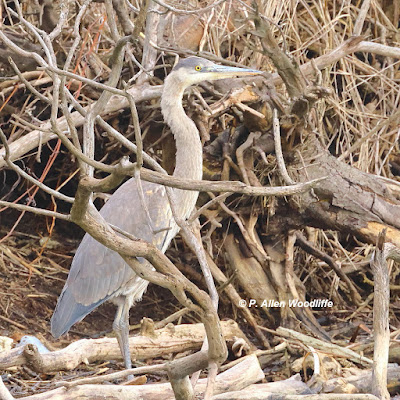But has it really been winter? Probably more to come, but hopefully not in April and May!
My blog posts are a bit out of sync. I am a few days behind the usual timing, but life sometimes gets in the way! Nonetheless I did get out periodically up until a few days ago.
One of the highlights was to get a few shots of this overwintering Red-headed Woodpecker.
Red-headed Woodpeckers are far less common than they used to be, even during the breeding season. Having one over-winter is extremely unusual. I hadn't seen this one since late December, but about a week ago, there it was, in virtually the same location. Fortunately it has been a mild winter, as the patch of wooded area is quite small and very exposed.My first attempts to photograph this individual did not result in much more than record shots. But I persisted, and even though these are highly cropped, it ventured out into more exposed areas of the trees it was moving around on, so got these much more satisfactory photos.
It was actually a short distance after leaving Rondeau that I re-encountered this individual. I had been at the park on several occasions, mainly to take advantage of the relatively mild, snow-free conditions for a good long walk. I didn't encounter many birds, but that wasn't my goal. Large wooded areas in mid-winter are typically very quiet when it comes to bird activity, much less photo opportunities for them. I did, however, come across the occasional Pileated Woodpecker, always nice to see....
....the somewhat unpredictable Eastern Screech Owl was sitting up nicely in its favourite American Beech........there are lots of Dark-eyed Juncos scattered here and there.....
...and I am usually on the lookout for a new species of lichen to photograph. This one is likely the Mealy Rim Lichen.
On the return home, I managed to get a cooperative Rock Pigeon sitting on a wire in good light. I find this species to be typically flighty, not wanting to sit for long when a vehicle approaches.
With lots of open water still available, Great Blue Herons are in various locations. This one was in a ditch right along the road, allowing me to get these photos from my vehicle window, even at close range.This next one was up along Bear Creek, across the channel.
While walking along the trail at St. Clair NWA, there wasn't much to photograph, but there always seem to be a few Canada Geese around.
I did manage to get this highly cropped photo of a Northern Harrier cruising by at a great distance. It was taken and cropped to the equivalent of about 80X, and hard to maintain spot on focus, so isn't the best, to be sure.
I spent a bit of time at Erieau where, in spite of all of the open water of the lake and bay, some birds hung close by the marina slips and immediate area. Several American Coot were close by....
There are several hundred to several thousand ducks around, most of which are well beyond good photo range. There were a dozen or more Redhead in the slip, including this nice male...
...and this female, apparently going through some unusual plumage change.
I usually go into southeastern Lambton Co once or twice a winter, as it is a good spot to see overwintering eagles. I have had moderate success in seeing and photographing Golden Eagles there, but not yet this year. This is one from a couple of years ago.
The only eagles I saw were these two Bald Eagles, perched in a tree well out in the open and a long way from the road.If you would like to subscribe, or unsubscribe, to Nature Nuggets, send an email to: prairietramper@gmail.com





















Were you able to identify what the red-headed woodpecker has in its beak? (I couldn't i.d. the food (?) or material when I zoomed in on the image but hoping you can.) Lovely photos and info, as always! Many thanks, Lorraine
ReplyDeleteGood question, Lorraine, and thanks for your comments. I suspect it is some kind of nut or berry. There were a number of holes in this tree trunk, and I expect the bird had been caching a few things from an earlier part of the season. It wasn't digging a hole, as the bird clung on to whatever food item it was rather than flick it out of the way, although I watched and did not see the bird consume it. It is probably hard to tell exactly what type of food item as Red-headed Woodpeckers eat primarily seeds or nuts or berries, depending on what is available. Given that it likely had been stored in that hole for weeks or even months, it is probably changed too much over time to figure out exactly what it is.
Delete